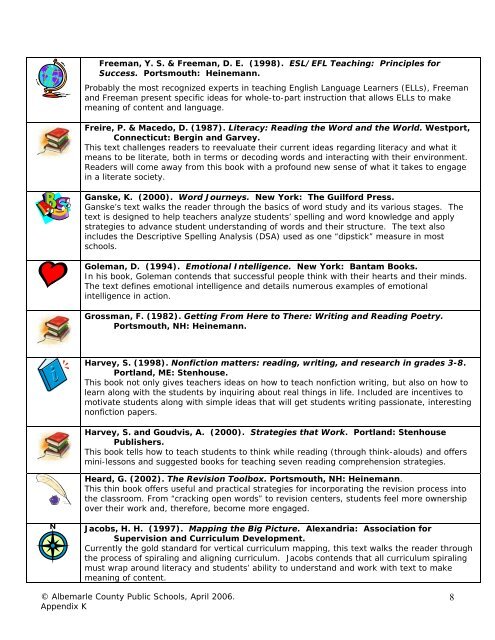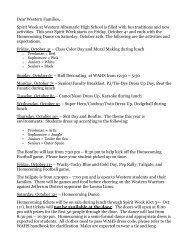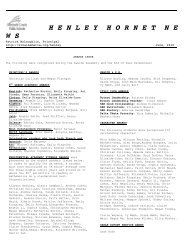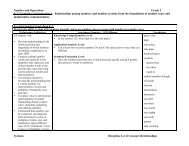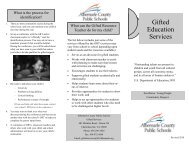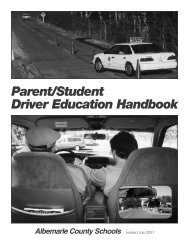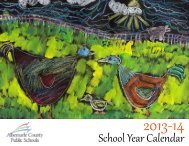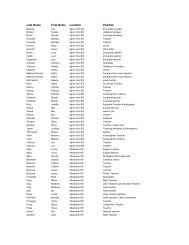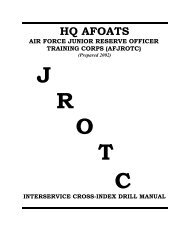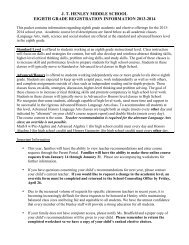Language Arts/English Curriculum Frameworks - Albemarle County ...
Language Arts/English Curriculum Frameworks - Albemarle County ...
Language Arts/English Curriculum Frameworks - Albemarle County ...
Create successful ePaper yourself
Turn your PDF publications into a flip-book with our unique Google optimized e-Paper software.
Freeman, Y. S. & Freeman, D. E. (1998). ESL/EFL Teaching: Principles for<br />
Success. Portsmouth: Heinemann.<br />
Probably the most recognized experts in teaching <strong>English</strong> <strong>Language</strong> Learners (ELLs), Freeman<br />
and Freeman present specific ideas for whole-to-part instruction that allows ELLs to make<br />
meaning of content and language.<br />
Freire, P. & Macedo, D. (1987). Literacy: Reading the Word and the World. Westport,<br />
Connecticut: Bergin and Garvey.<br />
This text challenges readers to reevaluate their current ideas regarding literacy and what it<br />
means to be literate, both in terms or decoding words and interacting with their environment.<br />
Readers will come away from this book with a profound new sense of what it takes to engage<br />
in a literate society.<br />
Ganske, K. (2000). Word Journeys. New York: The Guilford Press.<br />
Ganske’s text walks the reader through the basics of word study and its various stages. The<br />
text is designed to help teachers analyze students’ spelling and word knowledge and apply<br />
strategies to advance student understanding of words and their structure. The text also<br />
includes the Descriptive Spelling Analysis (DSA) used as one “dipstick” measure in most<br />
schools.<br />
Goleman, D. (1994). Emotional Intelligence. New York: Bantam Books.<br />
In his book, Goleman contends that successful people think with their hearts and their minds.<br />
The text defines emotional intelligence and details numerous examples of emotional<br />
intelligence in action.<br />
Grossman, F. (1982). Getting From Here to There: Writing and Reading Poetry.<br />
Portsmouth, NH: Heinemann.<br />
Harvey, S. (1998). Nonfiction matters: reading, writing, and research in grades 3-8.<br />
Portland, ME: Stenhouse.<br />
This book not only gives teachers ideas on how to teach nonfiction writing, but also on how to<br />
learn along with the students by inquiring about real things in life. Included are incentives to<br />
motivate students along with simple ideas that will get students writing passionate, interesting<br />
nonfiction papers.<br />
Harvey, S. and Goudvis, A. (2000). Strategies that Work. Portland: Stenhouse<br />
Publishers.<br />
This book tells how to teach students to think while reading (through think-alouds) and offers<br />
mini-lessons and suggested books for teaching seven reading comprehension strategies.<br />
Heard, G. (2002). The Revision Toolbox. Portsmouth, NH: Heinemann.<br />
This thin book offers useful and practical strategies for incorporating the revision process into<br />
the classroom. From “cracking open words” to revision centers, students feel more ownership<br />
over their work and, therefore, become more engaged.<br />
Jacobs, H. H. (1997). Mapping the Big Picture. Alexandria: Association for<br />
Supervision and <strong>Curriculum</strong> Development.<br />
Currently the gold standard for vertical curriculum mapping, this text walks the reader through<br />
the process of spiraling and aligning curriculum. Jacobs contends that all curriculum spiraling<br />
must wrap around literacy and students’ ability to understand and work with text to make<br />
meaning of content.<br />
© <strong>Albemarle</strong> <strong>County</strong> Public Schools, April 2006.<br />
Appendix K<br />
8


